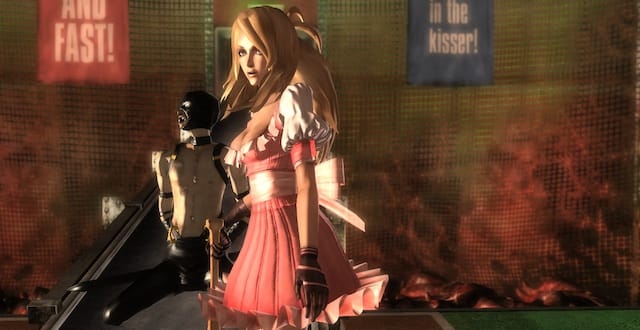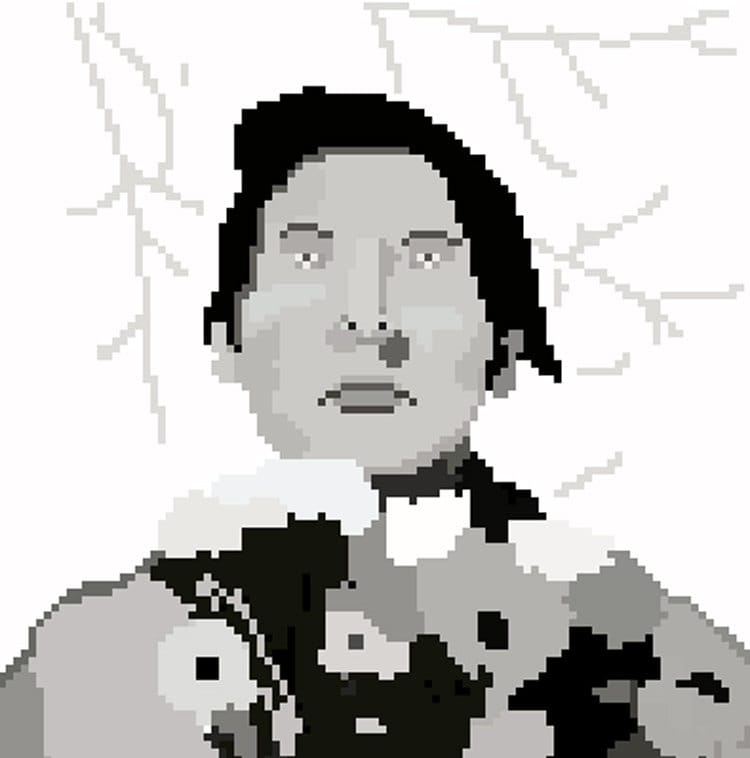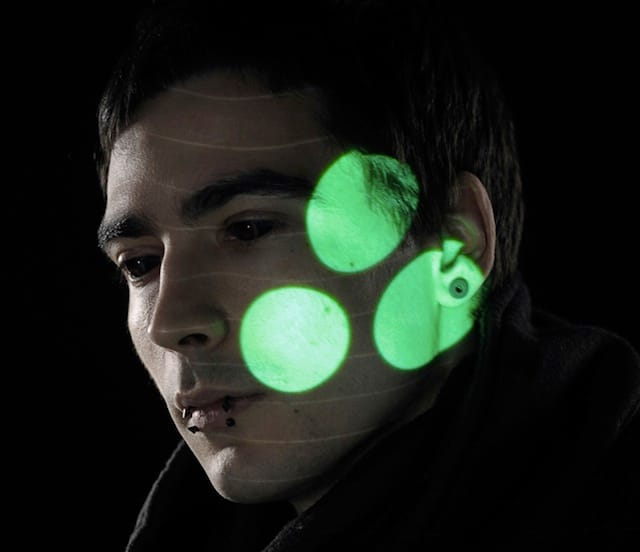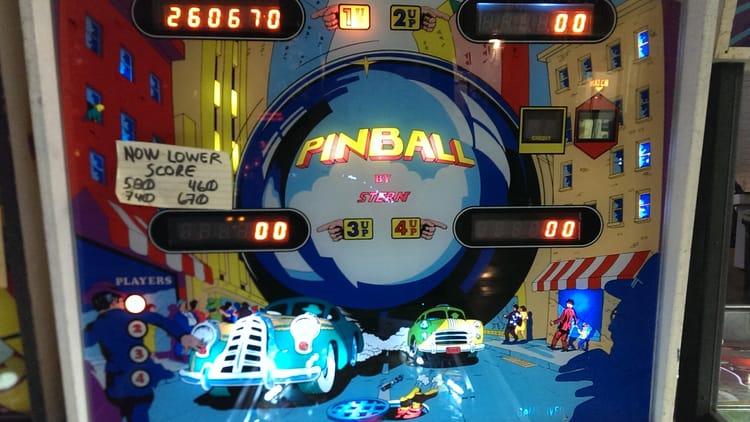The Nonsense Art of Suda51

It is a particular sickness of writers to want to make sense of everything. Writing about a game requires a logical and linear sequence of ideas to be connected. Criticism says that works are important, but that one’s interpretative understanding of a work is even more important—even in praise it is a defeat at the hands of the audience. Videogames agitate this phenomenon to an unusual degree because of the discrepancy between their functioning as systems and their signification as art, which critics like me hasten to interpret with stern attention.
The games of Japanese developer Goichi Suda (aka Suda51) are hostile to interpretive idealization in every aspect—from Killer7‘s elegant and obnoxious decision to take movement away from the joystick, to Lollipop Chainsaw‘s embrace of masculine fantasies about teenage sex and idiocy. In a speech given at the Game Developers Conference in 2007, Suda attempted to cohere his work under the umbrella category of punk. “I hate doing things that other people do,” he said. “I like to do what other people are not doing … developing games that nobody else will think about.”
Ironically, the punk label was eagerly embraced because it was safe and familiar, and it has led to a generally simplistic characterization of Suda’s work. Art such as his is often mistaken to represent uncomfortable or unflattering aspects of reality. But Suda’s work does not signify a coherent set of values. It is an art of nonsense that cannot be reduced by criticism into an essential state.
There are many little meanings, but no big meaning.
Irreducibility is a defining characteristic of surrealism, a tradition that illuminates Suda’s work. In his Surrealist Manifesto, André Breton described the “mind” as something that “attempts to embrace everything.” Its mechanism for experiencing the world makes descriptions of things that are separate from their beholders futile and dishonest. “Our brains are dulled by the incurable mania of wanting to make the unknown, classifiable,” Breton argued. “The desire for analysis wins out over the sentiments.”
/ / /
Killer7 (2005) is Suda’s most purely surreal work, an incomprehensible jumble of tones, characters, and interactive fragments that still make sense as a unified experience. Not only is movement arbitrarily reduced to holding down a button while the game code moves you further along its branching train tracks, it asks you to shoot invisible enemies that are detectable only by listening for their shrieking laughter. In other words, the most basic requirement for the game’s central mechanism—shooting—is made impossible by a presentation that inhibits sight.
One plays Killer7 in steps, holding down a movement button and listening, then holding down a shoulder button to look in first-person view, then pressing another button to activate a scan effect to make the enemies visible so they can finally be shot. This disruption does not imply any particular thematic or emotional interpretation. Instead it is hyper-formalist, creating space to observe all of the disparate elements involved in a shooting action that’s usually streamlined in videogames toward a point of perfect convenience.

Joined with this mechanic is the game’s character switching, in which one must morph into seven different people, each with their own particular weapons and movement abilities. This evokes the opening question of Breton’s Nadja, the surreal novel, which opened by braving the cliché “Who am I?” Scrubbed free of sarcasm, the question is the essential counterpoint to surrealism’s romance of the irreducible. If there is no summary truth to any thing in the world, then the subjective viewer given to interpret all these things must also be considered irreducibly complex.
“This sense of myself seems inadequate only in so far as it presupposes myself,” Breton wrote. Killer7 begins by presupposing many selves that are freely interchangeable, each of which is expressed through a paraplegic old man named Harman who can literally absorb their corpses. In the build-up to the finale, the game reveals each of the seven personas is actually a former victim of Harman’s. But even this sense of character does not illuminate Harman in any explanatory way. His “self” is a literal assembly of other people’s selves, which all but eliminates any conception of self that we might have for him. He is not a person so much as an open potentiality for any person.
In subsequent games, Suda’s flair for disruptive mechanics and irreducible selves has migrated toward self-conscious juvenilia. Inspired loosely by Alejandro Jodorowsky’s El Topo, an anarcho-acid film with a heavy debt to surrealism, Suda created the No More Heroes series (2008, 2010). The two games are a vulgar confetti of childhood fantasies—what a boy infatuated with wrestling, lightsabers, and pornography might imagine to be his adult life (“The mind which plunges into Surrealism relives with glowing excitement the best parts of its childhood,” Breton wrote in the Manifesto).
What matters is not the meaning but the depth and urgency of the experience.
No More Heroes‘ signifiers are so fecund they seem to psychoanalyze themselves at first. Travis is driven to kill his way through the ranks of the world’s most dangerous assassins by the promise of sex with a mysterious blonde who makes a point of always appearing before him in some barely clothed manner. The grand villain is Travis’ childhood love—and half-sister—who was sexually abused by Travis’ father and who has now become the top-ranked assassin in the world. She also shares the name of Travis’ cat, with whom players can relax between missions; feeding her, letting her sit on Travis’ stomach, and nuzzling her head for a few peaceful moments.
Yet there is no coherent moral frame which all these psychoanalytic signifiers could be made to fit in—the player feels the urge to use them as pieces in some act of moral block building, but the further one goes the more incongruent the pieces seem. As in Killer7, the game only seems to be sensible in small increments; but as each additional layer of detail is added to its story, it becomes a collection of associated fragments whose only meaningful connection to one another comes from the projected moral framework of the person who observed them all.
In Nadja, Breton admitted it was impossible to not see connections in his rambling list of memories, places, posters, books, letters, drawings, and music—used to evoke the spirit of a lost love affair—and yet he found it “quite impossible to establish a rational correlation between them.” He hoped this absence of sensible relation would “send some men rushing out into the street, after making them aware, if not of the non-existence, at least of the crucial inadequacy of any so-called categorical self-evaluation, of any action which requires a continuous application and which can be premeditated.”

No More Heroes‘ gameplay embodies this nonsensical arrangement of disruptive fragments with its beam-katana swordplay, though in a simpler way than Killer7. The periodic draining of the virtual katana’s battery requires pauses in fighting while players recharge it with a vigorous and masturbatory stroking gesture. The fighting is further interrupted by a “Dark Side” mode which supplements Travis’ attack abilities with superpowers that warp the screen in psychotically saturated greens and purples, the dramatic tension of combos and counters obscured by the blood geysers that come from enemies that can now be decapitated with a single hit.
The assassination missions are broken up with side jobs that include working a gas station, collecting coconuts on the beach, mowing lawns, harvesting scorpions from a grassy lot, and sweeping for buried mines. No More Heroes 2: Desperate Struggle made these games even more incongruous by transforming them into 8-bit throwbacks at complete odds with the 3D atmospherics of the rest of the game. Again, it’s easy to confuse the obviousness of what these individual elements signify—Dark Side mode is a clear metaphor for a psychotic break; side jobs are a comment on the simple mechanistic connections between videogames of all eras—but there is no all-encompassing signification. In contrast to, say, Grand Theft Auto IV, a game that coheres as a long and sarcastic tightening of a tourniquet around a well-meaning sucker who is slowly turned into a villain by repeatedly allowing himself to be a tool for thugs, crooks, and power brokers, the No More Heroes games are fragmentary and inconclusive. With all their psychodramas, toy fetishes, and strained male arousal, there are many little meanings, but no big meaning.
/ / /
Suda’s recent games have narrowed even further in tone and aesthetic, dampening the sense of randomness and irreducibility by seeming to embrace the shrill dead end of exploitation cinema. Shadows of the Damned and Lollipop Chainsaw favor linear structures and streamlined mechanics that minimize the disruptive elements from Suda’s earlier games, revealing a thinness to each game’s systems. Suda had always favored game design by contrasting disparate ideas rather than deep-diving into the mechanical complexity of any one mechanic. In both recent games, the story aesthetics and gameplay seem to adhere to the rules of their genre rather than subvert them. These games rely on tasteless confrontation in tone alone to enliven overfamiliar gameplay mechanics.

Shadows of the Damned is the masculine version of the violent exploitation tale, in which a “MexiCan” is led through hell to save his kidnapped girlfriend by an obvious penis stand-in, a talking skull gun called Johnson, which must be discharged at all the intervening demons protecting the man’s girlfriend. Lollipop Chainsaw was developed in partnership with Kadokawa Games and former Troma writer James Gunn, whose work on Tromeo and Juliet ridiculed the tendency of men to cover their emotional neediness with porn and sexual fixation. Lollipop Chainsaw trades the masculine exploitation cliché for a feminine one, a waterheaded cheerleader whose sexual signification makes the zombies she’s fighting fantasize about her defilement. One especially elastic enemy dreams of severing her head and “fisting” his anus with it.
For some it was impossible not to see these depictions as advocating a view of women that is incessantly sexual and bent toward the phallocentric male-pleasure paradigm. Lollipop Chainsaw is one of Suda’s most readily interpretable games. Just as one might argue against it as an example of misogyny, one might counter-argue that most all the men in the game are rotting zombies who are identified as the enemy, and the two male characters who are trustworthy are desexualized. Juliet’s boyfriend Nick is a severed head, and his lust has no instrument for expression, save the emotional and intellectual ties between him and her. Her father is a protective rockabilly bear who has no sexual interest in anyone save Juliet’s mother, and he eventually accepts Nick because he trusts Juliet’s independent ability to chose a partner for herself.
Interpreting the game as an empowerment yarn, however, where a woman gets to violently mutilate all the drooling sex monsters around her, doesn’t quite scan—especially considering the game’s creative heads are all men, and the majority of the audience for action games with chainsaws is very probably male. It might be more honest to see Lollipop Chainsaw as a bizarre ventilation of guilt, acknowledging how lurid and disfiguring these clichés must always be—men depicting themselves as monsters who need defeating at the hands of their own cultural creation.

But then this is the trap surrealism lays for us. Here I am, knee-deep in counter-interpreting signifiers in a work that, finally, has nothing to signify. Lollipop Chainsaw creates the urge to see models of morality and, in the tradition of exploitation, provokes disgust for what it knowingly leads its audience into interpreting. I am finally just talking about myself and using someone else’s body of work as the reason why people should care about my particular view of these elements. Surrealism seduces each beholder with the promise of reason discovered, which we cannot resist because its discovery is always self-aggrandizing. “In every domain the mind appropriates certain rights which it does not possess,” Breton wrote in concluding Nadja. “Beauty neither static nor dynamic. The human heart, beautiful as a seismograph.”
Seismography is probably the best description of Suda’s work. He is not an arranger of psychoanalytic or sociopolitical metaphors, but a composer of contrasts meant to induce sentiments of bigger and smaller magnitudes. What matters is not the meaning but the depth and urgency of the experience, something which surrealism evokes by juxtaposing non-sequiturs. Suda’s recent turn is a formal gesture that exploits our need to see art in terms of the sense it makes.
An earthquake can “mean” an infinite number of things because it affects an infinite number of lives, landmasses, and natural phenomena over time; it collapses structures placed along the surface, swallows individual lives, and reshapes continents. We respond to earthquakes but they cannot be defined in terms of our responses to them. Suda is finally not a punk nor an exploitation artist, but an arranger of structures and associations whose inevitable collapse are a seismographic heartbeat away—nonsense spaces crawled over by the brain-bound watchers who only want from the world a sensible illusion of their own making.



